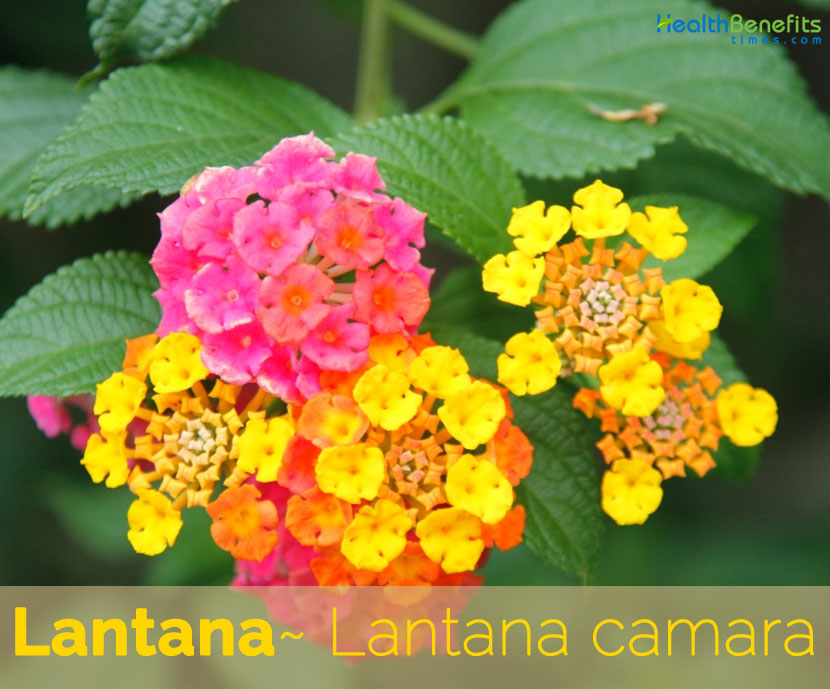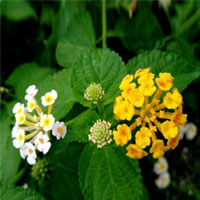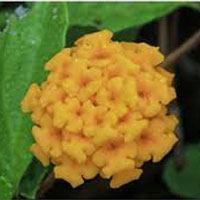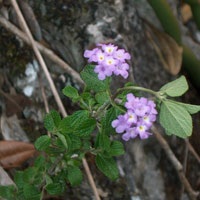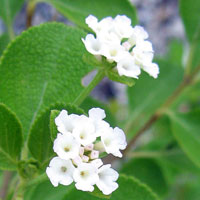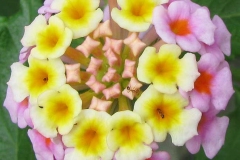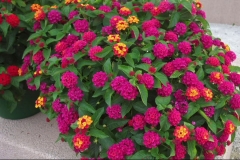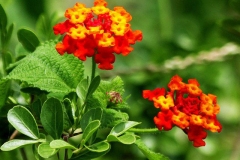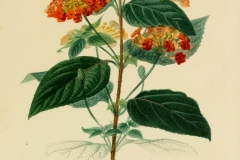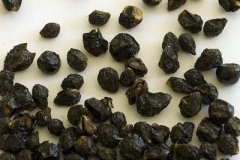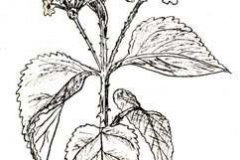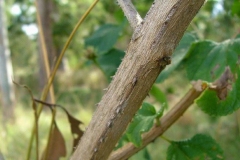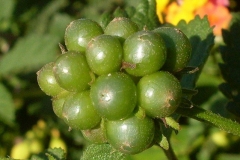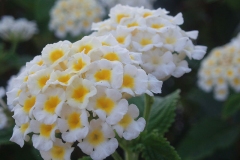| Lantana Quick Facts | ||
|---|---|---|
| Name: | Lantana | |
| Scientific Name: | Lantana camara | |
| Origin | Mexico, Central America, the Caribbean and tropical South America | |
| Colors | Green turning bluish-black color and have an almost metallic sheen | |
| Shapes | Round, fleshy, 2 seeded drupe, approximately 5 millimeters in diameter | |
| Taste | Sweet and tart, like a cross between black currants and cherries | |
| Health benefits | Alleviate Skin Disorders, Good for bones and joints, Astringent herbs, Treat cough, Alleviate Pain, Prevent free radicals, Improve Digestive System Health, Address Respiratory Issues, Stomach medicine, Increase appetite, Remove toxins from the body, Treat toothache, Overcome vaginal discharge problems, Repel Insects | |
| Name | Lantana |
|---|---|
| Scientific Name | Lantana camara |
| Native | Mexico, Central America, the Caribbean (i.e. the Bahamas, Cuba, Hispaniola, Jamaica and Puerto Rico) and tropical South America (i.e. Venezuela and Colombia) |
| Common Names | Big sage, Lantana verbena, arch man, common lantana, curse of India, kamara lantana, lantana, large-leaf lantana, large leaf lantana, pink flowered lantana, pink-flowered lantana, prickly lantana, red flowered lantana, red flowered sage, red sage, red-flowered lantana, red-flowered sage, shrub verbena, tick berry, white sage, wild sage, yellow sage |
| Name in Other Languages | Afrikaans: Gomdagga,Gewone Lantana Arabic: Lanitana muqusatan (لانتانا مقوسة) Bengali: Lānṭānā (লান্টানা) Brazil: Camara, cambara de espinho Bulgarian: Lantana (лантана), promenliva rozočka (променлива розичка) Cambodia: Ach mann Catalan: Bandera espanyola, Banderes, Lantana Chinese: Ma ying dan (马缨丹) Cook Islands: Ranatana, tataramoa Costa Rica: Cinco negritos, flor de duende, tres colores Comorian: Tramba mzungu, Bwasera Créole Maurice: Vieille fille Créole Réunion: Corbeille d’or,Galaber Créole Seychelles: Vieille fille,Vyey fiy Danish: Almindelig Ildkrone Dutch: Wisselbloem El Salvador: Bandera española English: Common Lantana, Kamara lantana, Largeleaf lantana, Wild sage, lantana, Hedgeflower, Cherry pie, Ubuhobe besikhiwa, red sage, shrub verbena, white sage, yellow sage, arch man, pink-flowered lantana, prickly lantana, red-flowered sage, tickberry, Bahama tea, Lantana, Miss huff hardy lantana Fijian: Kauboica, kaumboitha, lanitana, mbona ra mbulumakau, mbonambulumakau, tokalau, waiwai Filipino: Bahug-bahug, sapinit Finnish: Kirjotulikruunu French: Caca martin, corbeille d’or, galabert, lantana, vieille fille, lantanier, mille fleurs, tatara moa, viorne américaine German: Wandelröschen Greek: Lantana (Λαντάνα) Guinea: Boulé kogno, kogno porto Haiti: Bonbonier, herbe à plomb, herbe au diable, herbe bourrique Hawaiian: La‘au kalakala, lakana, lanakana, mikinolia hihiu, mikinolia hohono, mikinolia kukū Hebrew: Lantana sasgonit, לנטנה ססגונית, לנטנה ססגונית, לַנְטָנָה סַסְגּוֹנִית Hindi: Bands, nagaairi, phullaki, putus, tantbi, guphul, Raimuniya (राईमुनिया) Hungarian: Sétányrózsa I-Kiribati: Te kaibuaka Indonesian: Boenga pagar, chente, kembang satik, kembang telek, oblo, puchengan, puyengan, saliara, saliyere, sliyara, tahi agam, tai hayam, tai kotok, telekan, tembelek, tembelekan, teterapan, waung, wileran Irula: Unni chedi, Paralai chedi, Nandhana chedi Italian: Camara, lantana, viburno americano Japanese: Shichihenge (シチヘンゲ), rantana(ランタナ) Kannada: Lantana (ಲಂಟಾನ), Kakke, Natahu Kinyarwanda: Umuhengeli Kiribati: Te kaibuaka Kosraean: Ros fonacni Lesser Antilles: Measle bush, rangoat leaf, sauge, scrubby tree Madagascar: Fankatavinakoho, fotatra, mandadrieko, radredreka, rajejeka, ramity Malagasy: Ramity, Radredreka, Radriaka Malay: Tahi ayam, Pokok Bunga Tahi Ayam Malaysia: Bunga asam senyur, bunga pagar, bunga tahi anjing, bunga tahi asu, bunga tahi ayam, bunga tahi ayam busok, tahi ayam munai Malayalam: Lanṟāna kamāra (ലന്റാന കമാര) Mangarevan: Tara koa Manipuri: Samballei (সম্বল লৈ), Nongballei, Thirei (থীরৈ) Maori (Cook Islands): Rānatāna, tātarāmoa, tātarāmoa papa‘ā, tūtae ‘oro‘enua Marathi: Tantani (तणतणी), Ghaneri (घाणेरी) Marshallese: Lantõna Mauritius: Vieille fille Mexico: Alantana, alfombrilla hedionda, carrasposa, confite, confituria, confiturilla, confiturio, flor de San Cayetano, lampana, matizadilla, pasaruin, scrubby cap, sonora roja, uña de gato Micronesia, Federated states of: Randana (Pohnpei) Nauruan: Migiroa Nepali: Ganhā’unē kām̐ḍā (गन्हाउने काँडा), Masino Kaandaa (मसिनो काँडा) Van Phandaa (वन फन्दा) Nicaragua: Cuasquito Oriya: Nāga airi (ନାଗ ଐରି) Persian: شاهپسند درختچهای Philippines: Bahug-bahug, sapinit Pohnpeian: Landana, randana, rantana, tuhke suwed, tukasuweth Portuguese: Camara, Cambará, Lantana, camará-de-cheiro, camará-de-espinho, camará-de-folha-grande, camará-vermelho, cambará-de-chumbo, cambará-juba, cambará-miudo, cambará-verdadeiro, freira, lantata trepadeira, trepadeira, cambará-de-espinho Puerto Rico: Cariaquillo Russian: Lantana svodchataya (Лантана сводчатая), lantana kamara (лантана камара), lantana svod chata lantana (лантана сводчатаяrantana) Saint Helena: Wild currant Samoa: Lantana, latana, lõtana Shona: Mbarapati, Sumba Sinhalese: Gan̆dapāna (ගඳපාන) South Africa: Boesmandruiwe, cherry-pie, common lantana, gewone lantana, gomdagga, sumba, voelbrandewyn, wild lantana, wilderoosmaryn, yellow sage Spanish: Bandera española, Banderas, Camara, Espuela de galán, Lantana, Verbena, cuasquito, supirosa, camar, cariaquillo, cinco cincos, cinco negritos, comida de paloma, corroncho, filigrana, frutilla, jaral, jarrila, mora de caballo, morita, palo del Diablo, santo negrito, soterre, venturosa, maestrante del Brasil, té de Bahamas, hierba zorra, coronchocho, pasarin Sri Lanka: Ganda-pana, garda-pana, genda-pana, katu-hinguru, rata-guru, ton-kinna Sundanese: Saliara Swedish: Eldkrona Tagalog: Kantutay Tahitian: Tātarāmoa, taratara hamoa, tatara moa Tamil: Unnichedi (உண்ணிச்செடி) Telegu:Talambrālu ceṭṭu (తలంబ్రాలు చెట్టు), Pulikampa Thai: Kamkung, paka krawng, pha-ka-krong (ผกากรอง) Tonga: Talatala, Talamoa Turkish: Calıminesi Tuvaluan: Kai puaka, kaipuaka USA/Hawaii: Lakana, lanakana, mikinolia hihiu, mikinolia kuku Venezuela: Cariaquillo, cariaquito Vietnamese: Bông ổi, thom oi Zimbabwe: Chiponiwe Zulu: UBukhwebezane |
| Plant Growth Habit | Low, invasive small, erect or sub-scandent, vigorous perennial shrub |
| Growing Climates | Cultivated land, fence lines, pastures, rangelands, valleys, mountain slopes, coastal areas, wastelands, rainforest edges, beachfronts, roadsides, railways and areas recovering from fire or logging, grasslands, secondary forest, waterways, fence-lines, disturbed sites, closed forests, forest margins, plantation crops, pastures and parklands |
| Soil | Grow best in moist, well-drained soil, that’s slightly acidic, but they can survive in drier conditions. Drainage is important as they don’t live as long with wet roots |
| Plant Size | Around 6-15 ft. (1.8-4.6 m) tall |
| Root | Root system is very strong with a main taproot and a mat of many shallow side roots |
| Stem | Woody, square in cross section, hairy when young, cylindrical and up to 15 cm thick as it grows older |
| Leaf | Simple, opposite, decussate carried by a petiole, 1.5 to 2 cm long. The blade is leathery, oval to broadly oval shaped, 5 to 8 cm long and 3-4 cm wide, truncated to subcordate at the base, acute or acuminate at the top |
| Flowering season | August and March |
| Flower | Small, multi colored, in stalked, dense, flat-topped clusters to 4 cm across |
| Fruit Shape & Size | Round, fleshy, 2 seeded drupe, approximately 5 millimeters in diameter, roughly the size of a peppercorn |
| Fruit Color | Round, fleshy, 2 seeded drupe, approximately 5 millimeters in diameter, roughly the size of a peppercorn |
| Seed | Single hard, light brown, egg shaped, stony seed (2-4 mm long) at its center |
| Propagation | Stem cuttings and by seeds |
| Taste | Sweet and tart, like a cross between black currants and cherries with chocolate undertones |
| Plant Parts Used | Whole plant, leaves, root, flower |
| Season | September to May |
| Health Benefits |
|
Stems
The young stems are usually green and square in cross-section (i.e. quadrangular). They are rough to the touch, often armed with short backwards-curved (i.e. recurved) prickles, and can sometimes be slightly hairy (i.e. puberulent). As they mature the stems become rounded and turn grey or brown in color (growing up to 15 cm thick).
Leaves
The simple leaves are oppositely arranged along the stems and borne on stalks (i.e. petioles) 5-20 mm long. They have toothed (i.e. crenated or serrated) margins and a somewhat wrinkled (i.e. rugose) appearance. The leaf blades (2-13 cm long and 1.5-7 cm wide) are mostly egg-shaped in outline (i.e. ovate) with pointed tips (i.e. acuminate apices). The texture of the leaves is usually quite rough (i.e. scabrous), however the undersides are usually softly hairy (i.e. pubescent).
Flower
Small tubular shapes flowers are borne in dense clusters (2-4 cm across), with each cluster containing about 20-40 flowers. These flower clusters are borne on stalks (i.e. peduncles) 2-10 cm long that originate in the leaf forks (i.e. axils). Individual flowers are tubular about 9-14 mm long and 4-10 mm across and may be a great variety of colors (i.e. white, cream, yellow, orange, red, pink or multi-colored depending on location in inflorescences, age, and maturity). They consist of four (rarely five) petals that are fused for most of their length into a tube (i.e. corolla tube) and split into small lobes at their tips. Flowering occurs throughout most of the year, but is most apparent during the spring and summer months. After pollination occur the color of the flowers changes (typically from yellow to orangish, pinkish, or reddish); this is supposed to be a signal to pollinators that the pre-change color contains a reward as well as being sexually viable, thus increasing pollination efficiency.
Fruit
Fruit of L. camara is a round, fleshy, berry-like 2 seeded drupe approximately 5 millimeters in diameter, roughly the size of a peppercorn. These berries are green when young turning to bluish-black color and have an almost metallic sheen. Green unripe fruits are inedible to humans and animals alike. Because of dense patches of hard spikes on their rind, ingestion of them can result in serious damage to the digestive tract. Both vegetative (asexual) and seed reproduction occur. Up to 12,000 fruits can be produced by each plant which is then eaten by birds and other animals which can spread the seeds over large distances, facilitating the spread of L. camara. Each fruit contains a single hard and stony seed (2-4 mm long) at its center. These seeds are light brown in color and egg-shaped (i.e. ovoid).
General characteristics of Lantana camara
| Characteristics | Description |
| Native | Tropical region in Central and South America |
| Synonym | Camara vulgaris, Lantana scabrida |
| Distribution | Naturalized in countries/islands between 350 N and 350. S latitudes |
| Conservation Status | Alien |
| Plant Category | Annuals and biennials, ground covers, perennials, shrubs |
| Plant Characteristics | Poisonous |
| Foliage Characteristics | Fragrant, evergreen, poisonous |
| Foliage Color | Dark green |
| Flower Characteristics | Long lasting, showy, unusual |
| Flower Color | Pink, yellow, orange |
| Tolerances | Drought, heat and humidity, pollution, slope, wind |
| Propagation Methods | From herbaceous stem cuttings |
| Pollinators | Lepidopteran species and thrip |
Habitat description
| Habitat Parameters | Requirements |
| Light range | Sun to full Sun |
| pH Range | 4.5 – 8.5 |
| Temperature | Intolerant of frequent or prolonged freezing |
| Annual Rainfall Range | 1000 – 4000mm |
| Soil Range | Mostly sandy to clay loam |
| Water Range | Semi-Arid to Normal |
| Altitudes | Less than 2000 m above sea level |
| Light Conditions | Prefers unshaded habitats, can tolerate some shade |
Common Lantana Varieties
Lantanas are available in a rainbow of colors, and more are being introduced all the time. Varieties may grow low to the ground as a plant or get a little taller like a shrub. Some of the common shades are red, white, blue, yellow, orange, and even blue, but many plants feature blooms that change hue as the season progresses. Let’s take a look at some of the most popular varieties and their characteristics:
1. Lantana camara
Also known as Spanish Flag, this is the most widely available varieties of lantana, and there are many cultivars within this species such as Dallas Red and Irene. In fact, when a lantana plant is label simply as “Common Lantana,” it’s extremely likely it’s a camara cultivar.
2. Lantana montevidensis
This variety often is referred to as trailing lantana or shrub verbena. It comes in many different colors and can bloom year-round in tropical climates. It’s often used ornamentally in flower gardens.
3. Lantana depressa
The name says it all for this variation, which spreads like ground cover and features small, colorful blooms.
4. Lantana strigosa
Rough Shrubverbena earns its name from its “hairy” leaves. The blooms, however, are identical to those found on common lantana varieties.
5. Lantana involucrate
This variety loves tropical areas and also may be called buttonsage or wild sage because of its fragrance.
Uses of Lantana camara
| Parts Used | Uses |
| Plant | Act as hedge plant, provide perch sites and cover |
| Flower | Nectar source for butterflies and moths |
| Bark | Astringent and used as a lotion in cutiginous eruptions, leprous ulcers |
| Stalks
|
Raw material for paper pulp which is used for wrapping, writing and printing paper |
| Making baskets and temporary shelters | |
| Used as Biofuel | |
|
Leaves |
Boiled and applied for swellings and pain in the body |
| Alkaloidal fractions lower blood pressure, accelerate deep respiration and stimulate intestinal movements | |
|
Plant Extracts |
Drought-tolerant plant so good candidates for xeriscaping |
| Used in folk medicine for the treatment of cancers, chicken pox, measles, asthma, ulcers, swellings, eczema, tumors, high blood pressure, bilious fevers, catarrhal infections, tetanus, rheumatism and malaria |
Health benefits of Common Lantana
Despite its popular nickname, the Lantana Camara herb is not related to the Sage plant family. The somewhat hairy shrub (Lantana) produces a spicy, pungent odor when bruised. Not only functions as an ornamental plant but the health benefits of Lantana Camara affect body health as follows
1. Alleviate Multiple Skin Disorders
The potent herb can be topically applied to ease various common skin disorders, particularly measles, chicken pox, scabies and skin fungus. There are scientific findings that indicate that Lantana Camara can be used to heal wounds due to its fast-acting antiseptic and antimicrobial properties.
2. Good for bones and joints
Maybe you are one who has bone health or joint disease. Be happy because you can treat it naturally with this plant. Take the leaves from the Lantana Camara plant and puree it. After that apply on the bones or joints that hurt. Diseases that can be cured include low back pain, rheumatism, and muscle aches.
3. Astringent herbs
Being a potent antiseptic, the natural herbal remedy can then be used to clean and disinfect minor wounds. This alone plays a main role towards healing. According to a recent scientific study, Lantana Camara can increase the rate of wound (wounds sustained from burns) contraction by almost 90%.
4. Treating cough
Cough is a disease that often occurs. Many ways you can do to cure cough in herbal. One way is by gargling Lantana Camara water.
5. Alleviating Pain
Lantana Camara can be used to alleviate various types of pain. Natural herbal remedy is so effective in alleviating pain that it was traditionally used to treat snakebites when directly applied on the affected area. This herb can also be topically applied to soothe insect stings and bites. Clinical scientific studies also indicate that L. Camara can be used to alleviate headaches, joint pain, toothache and any other type of pain.
6. Prevent free radicals
Free radicals are very harmful to the body. Therefore, protecting yourself from free radicals is very important. One of them is with this Lantana Camara plant. Because this herbal plant contains antioxidants. Besides, the Lantana Camara is also carcinogenic.
7. Improving Digestive System Health
The powerful natural herbal remedy can also be taken to improve overall digestive system health. L. Camara consists of powerful antimicrobial compounds that can be used to get rid of any harmful bacteria that can be found in the stomach. Apart from that, this amazing natural herbal remedy can also be used to ease multiple stomach disorders including bloating, indigestion, stomachache, diarrhea, and ulcers just to name a few.
Multiple animal laboratory studies prove that the herb can be used to reduce ulcer development. It is, however, important to note that these tests have only been carried out on rat specimens. Hence; further research is essential to demonstrate this property in humans.
8. Addressing Respiratory Issues
Lantana Camara herb can be used to ease numerous common respiratory issues. Tea made from the leaves of the potent herbal remedy provides an almost instant relief from coughs, colds, and flu. Taking a decoction that has been made from the dried flowers of the L. Camara plant has been shown to cure pulmonary tuberculosis.
Numerous scientific studies indicate that the natural herbal remedy is a super-effective relaxing expectorant that can be used to get rid of the phlegm and mucus. That is present in the lungs, trachea, and bronchi. Always use L. Camara has an inhalant to address all your respiratory issues.
9. Stomach medicine
Stomach ache is classified as a mild disease. However, abdominal pain can interfere with daily activities. A simple way you can do at home is to take a few leaves of health benefits of Lantana Camara. Then add it with oil, and then rub it on the sick stomach.
10. Increase appetite
Do you want an ideal body but your appetite decreases? Don’t worry. You can overcome this by consuming this Lantana Camara plant not leaves or flowers, but take the stems of these plants and then boil with water then drink.
11. Remove toxins from the body
Consuming Lantana Camara helps in removing toxins from the body. Toxins that accumulate in the body will make the organ’s performance cannot be maximized. Therefore the poison must be removed.
12. Treat toothache
Another benefit that you can get by consuming the health benefits of Lantana Camara is to treat toothache.
13. Overcoming vaginal discharge problems
Leucorrhoea problems are often experienced by women. To overcome these problems you can use this ornamental plant as medicine.
14. Repelling Insects
According to scientific studies that were conducted in India, the leaves of the Lantana Camara plant contain potent insecticidal properties that can be used to repel and even kill harmful insects. L. Camara can then be used to prevent malaria due to its ability to repel and even kill mosquitoes.
The methanolic and ethanolic extracts of this natural herbal remedy have been all shown to contain larvicidal properties. This means that apart from repelling potentially harmful insects, L. Camara can also be used to prevent such insects from proceeding from the larval life stage.
Traditional uses and benefits of Common Lantana
- The plant has antimicrobial, fungicidal, insecticidal, and nematocidal properties.
- Essential oil obtained from the plant is used for the treatment of skin itches, wounds, leprosy, and scabies.
- Root is used for influenza, cough, mumps, fever, malaria, toothache, headache, etc.
- Flowers are used for hemoptysis and pulmonary tuberculosis.
- Conditions like constipation, high blood pressure, dermatitis, eczema, measles, urethral inflammation, colds, and bronchitis among others can also be treated using plant parts of L. camara.
- Plant is often used in domestic medicine and research carried out mainly in India has shown it to contain a number of compounds with medicinal activity.
- Extracts have shown antimicrobial, fungicidal, insecticidal and nematicidal activity.
- Lantana essential oil is occasionally used for the treatment of skin itches, as an antiseptic for wounds, and externally for leprosy and scabies.
- It is applied as a poultice on rheumatic joints.
- Root is sweet and bitter tasting, refrigerant, antifebrile.
- Decoction is used to treat influenza, cough, mumps, incessant high fever, malaria, cervical lymph node tuberculosis, asthma, toothache, headache, inflammation, gonorrhea and leucorrhoea.
- Flowers are sweet tasting, mildly cooling and haemostatic.
- Decoction of the dried flowers is used in the treatment of haemoptysis and pulmonary tuberculosis.
- Leaves are aromatic with a minty taste, they have a cooling nature, are anti-phlogistic, and anti-dermatosic, diaphoretic, febrifuge, pectoral, stimulant, tonic and vulnerary.
- An infusion of the leaves and flowering tops is used in the treatment of fevers, constipation, tuberculosis, catarrh and bronchitis.
- Combined with the leaves of Cymbopogon citratus, they are used as an infusion to treat colds, high blood pressure and malarial fever.
- Externally, the leaves and stems are used as a wash to treat dermatitis, eczema, pruritus, measles and chickenpox rashes etc.
- They are applied as a poultice to treat sprains, wounds and contusions.
- As a douche, they are used to treat inflammations of the uterus.
- Decoction of the bark is used as a treatment for fevers.
- Plant extracts are used in folk medicine for the treatment of cancers, chicken pox, measles, asthma, ulcers, swellings, eczema, tumors, high blood pressure, bilious fevers, catarrhal infections, tetanus, rheumatism and malaria.
- Tea prepared from the Lantana camara leaves and flowers was taken against fever, influenza and stomach-ache.
- Infusion of the whole plant was used for bronchitis and the powdered root in milk was given to children for stomach-ache in Ghana.
- It was recommended that it may be useful in reducing fevers, and as a treatment of asthma and hypertension.
- Decoction of fresh roots used as gargle for toothaches, and a decoction of the leaves and fruits to clean wounds in Philippines.
- Decoction or syrup of roots (in sugared water) used for asthma.
- Strong decoction of leaves taken internally and poultice of wounds applied to the wound in Sinaloa.
- Decoction of plant is used for tetanus, rheumatism, malaria.
- Decoction of fresh leaves is used as gargle for toothaches.
- Leaves applied to swellings; also used as lotion or fomentation for rheumatism in Java.
- Decoction of leaves is used internally as emetic.
- An aromatic infusion of the leaves and flowering tops, sometimes mixed with Ocimum, is used as febrifuge and diaphoretic in West Africa.
- In Uganda, used to treat symptoms of tuberculosis.
- Leaf infusion is used as stimulant in Costa Rica.
- Infusion of leaves is used for bilious fevers and catarrhal affections.
- Lotions are used externally for eczematous eruptions.
- Infusion of flowers is used as pectoral for children.
- Tincture of bark is used as tonic.
- Pounded leaves are used as antiseptic for cuts, ulcers and swelling.
- Decoction of leaves and fruits is used for wounds.
Specific Recommendations for Using Lantana
- Chicken Pox: Boil and drink a cupful two times daily. Also use as a bath when chickenpox is about three days along.
- Wasp Stings and Itching Skin: Immediately after getting stung by a wash, crush a few lantana leaves until they become soft and juicy, then rub the juice into the stung area to prevent swelling and relieve pain.
- The crushed leaves can also be rubbed on irritated skin to relieve itching.
- Measles: Boil the leaves and drink about four times a day.
- Influenza, cough, mumps: Use 30 to 60 dried roots or 60 to 120 gm. fresh roots in decoction.
- Fever: Take decoction of bark or infusion of leaves and flowering tops as
- Hemoptysis, pulmonary tuberculosis: Use 6 to 9 gm. dried flowers in decoction.
- Dermatitis, eczema, pruritus: Use fresh stems and leaves.
- Rheumatism: Spread oil on leaves, warm over low flame and apply on affected part.
- Sprains, wounds, contusions: Use pounded fresh leaves applied as poultice.
Culinary Uses
- Berry-like drupe, dark purple or black fruits are eaten when fully ripe.
- Aromatic leaves are used to make a tea.
- Ripe black fruits are eaten in handfuls, especially by children as a snack.
Other Facts
- Due to its extensive root system, the plant is also planted for soil erosion control and sometimes grown as a hedge.
- Plant responds well to trimming and is often grown as a hedge.
- Plant provides an abundance of organic matter which can be used as mulch material.
- The use of lantana extracts as potential biocides has been suggested.
- Stems of lantana, if treated by the sulphate process, can be used to produce pulp for paper suitable for writing and printing.
- Roots of lantana consist of a substance that may possibly be used for rubber manufacture, although the economic viability of production has not been examined.
- Plant is utilized as firewood.
- Twigs and stems serve as useful fuel for cooking and heating in many developing countries, although it is less important than other fuel sources such as windrows, woodlots or natural bush.
- Lantana camara stalks have been used in the construction of furniture, such as chairs and tables.
- Mature plants produce up to 12,000 seeds annually.
- Toothbrushes are made from the stems in Taiping.
- When crushed, whey leaves a deep inky stain which may be used to create a light purple dye.
Impacts of Lantana camara
| Techniques | When to use | When not to use |
| Biological Control | · Bio-control agents are available and not already present | · Bio control agents, if affect important species |
| Mechanical Control | · Area suitable for access by machinery without significant damage and action
· Not leading to further land degradation |
· Close to rivers, creeks and drainage and lines, as damage to soil will impair water quality and increase erosion
· If not possible to follow up with treatments such as chemical or manual removal |
| Manual Removal | · Cheap labor available
· Limited area to clear · When used as a follow-up technique after fire or mechanical removal |
· Cost of labor outweighs land value |
| Fire Control | · Extensive area
· Little risk of fire spreading |
· Species may increase the intensity and frequency of fire inappropriately. Not to be used unless treatment with chemical |
Prevention and Control
Due to the variable regulations around (de)registration of pesticides, your national list of registered pesticides or relevant authority should be consulted to determine which products are legally allowed for use in your country when considering chemical control. Pesticides should always be used in a lawful manner, consistent with the product’s label.
Cultural Control
Being poisonous to livestock means that the species cannot be controlled using large herbivores. In fact, intense grazing by goats and donkeys will favor L. camara infestations by suppressing competition from palatable species.
Osunkoya et al. suggest from studies and simulation models in Queensland, Australia that periodic burning could control the weed in forests within 4-10 years if fire frequency is at least every two years. On farms, site-specific control may be achieved by 15 years if the biennial fire frequency is tempered with increased burning intensity.
Mechanical Control
Mechanical control can be effective, particularly where land is cleared, but requires continual follow-up treatment to remove roots and seedlings of L. camara. Slashing and burning stimulate suckering. Both chemical and mechanical control methods are expensive and labor intensive and are only effective in the short term. Cleared areas are rapidly colonized via seeds originating from distant parents or from sprouting roots. Dohn et al. recommend hand pulling for creating firebreaks or where minimizing damage to native species is paramount.
Chemical Control
The Australian experience in controlling L. camara, reviewed by Swarbrick et al., indicates that some herbicides are more effective on particular forms of L. camara. The most effective herbicides belong to the phenoxy acid, benzoic acid and pyridine groups. Glyphosate, sulfonylureas and imidazolinones also show good activity. Photosynthetic herbicides are not effective. A number of factors affect the effectiveness of the chemical treatment and they include: plant size, time of application, mode of application, and the use of surfactant. Use of herbicide in uncut stands may not be effective in preventing eventual regrowth. Combination of mechanical and chemical control may be the best. The seasonal response of L. camara to applications of fluroxypyr, metsulfuron-methyl, glyphosate and dichlorprop has been reported by Hannan-Jones.
Biological Control
Worldwide, well over 200 releases of bio-control agents have been made, however, in the majority of cases the control agent either failed to become established or became established without achieving control. Despite this limited success, classical biological control is still considered to be the only viable, long-term control option, since it offers a safe, economic and environmentally benign method of suppressing the weed. Most of the releases have been carried out in the Pacific, South Africa and Australia (for historical details see Taylor 1989; Cilliers and Neser, 1991; Denton et al., 1991; Davis et al., 1992; Swarbrick et al., 1995). The most widely established species include Ophiomyia lantanae, Uroplata girardi and Octoma scabripennis. Day et al. (2003) have produced a detailed review of 48 of these control agents.
Precautions
- The leaves and seeds are toxic.
- Green and partially ripened berries are toxic and can be lethal.
- Unripe, green berries cause vomiting, diarrhea, dilated pupils and labored respiration if ingested.
- Leaves may cause dermatitis.
- All parts of plant are poisonous if ingested.
- High consumption of lantana can lead to liver and kidney dysfunctions, liver and kidney failure, and possibly death!
- It is not advisable to grow lantana near places of residence as this plant has been known to harbor snakes, mosquitoes, and tsetse flies.
References:
https://www.itis.gov/servlet/SingleRpt/SingleRpt?search_topic=TSN&search_value=32175#null
http://www.hear.org/pier/species/lantana_camara.htm
https://pfaf.org/user/Plant.aspx?LatinName=Lantana+camara
https://www.cabi.org/isc/datasheet/29771
https://www.missouribotanicalgarden.org/PlantFinder/PlantFinderDetails.aspx?kempercode=a523
http://www.floracatalana.net/lantana-camara-l-
https://plants.usda.gov/core/profile?symbol=LACA2
https://en.wikipedia.org/wiki/Lantana_camara
https://npgsweb.ars-grin.gov/gringlobal/taxonomydetail.aspx?id=463177
http://www.fao.org/forestry/13375-06ba52ce294a4e15f8264c42027052db0.pdf
https://en.wikipedia.org/wiki/Lantana
http://www.flowersofindia.net/catalog/slides/Lantana.html
http://www.theplantlist.org/tpl1.1/record/kew-107934
https://gd.eppo.int/taxon/LANCA
https://keyserver.lucidcentral.org/weeds/data/media/Html/lantana_camara.htm
http://www.iucngisd.org/gisd/species.php?sc=56
https://indiabiodiversity.org/species/show/266152
http://www.ijsrp.org/research-paper-1013/ijsrp-p2207.pdf


